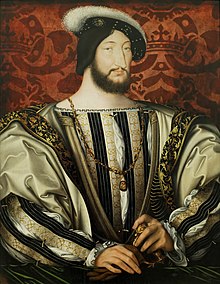
Back Frans I van Frankryk Afrikaans فرانسوا الأول ملك فرنسا Arabic فرانسوا الاول ملك فرنسا (سياسى من مملكه فرنسا) ARZ Franciscu I de Francia AST François I (gazik ke Franca) AVK I Fransisk Azerbaijani بیرینجی فرانسوا AZB Францыск I Byelorussian Франсоа I Bulgarian Frañsez Iañ (Bro-C'hall) Breton
| Francis I | |
|---|---|
 Francis I, c. 1527–1530 | |
| King of France | |
| Reign | 1 January 1515 – 31 March 1547 |
| Coronation | 25 January 1515 |
| Predecessor | Louis XII |
| Successor | Henry II |
| Duke of Milan | |
| Reign | 11 October 1515 – 20 November 1521 |
| Predecessor | Massimiliano Sforza |
| Successor | Francesco II Sforza |
| Born | Francis of Orléans 12 September 1494 Château de Cognac, Cognac, France |
| Died | 31 March 1547 (aged 52) Château de Rambouillet, France |
| Burial | 23 May 1547 Basilica of St Denis, France |
| Spouses | |
| Issue more... | |
| House | Valois-Angoulême |
| Father | Charles, Count of Angoulême |
| Mother | Louise of Savoy |
| Religion | Catholicism |
| Signature |  |
Francis I (French: François Ier; Middle French: Francoys; 12 September 1494 – 31 March 1547) was King of France from 1515 until his death in 1547. He was the son of Charles, Count of Angoulême, and Louise of Savoy. He succeeded his first cousin once removed and father-in-law Louis XII, who died without a legitimate son.
A prodigious patron of the arts, he promoted the emergent French Renaissance by attracting many Italian artists to work for him, including Leonardo da Vinci, who brought the Mona Lisa, which Francis had acquired. Francis' reign saw important cultural changes with the growth of central power in France, the spread of humanism and Protestantism, and the beginning of French exploration of the New World. Jacques Cartier and others claimed lands in the Americas for France and paved the way for the expansion of the first French colonial empire.
For his role in the development and promotion of the French language, he became known as le Père et Restaurateur des Lettres (the 'Father and Restorer of Letters').[1] He was also known as François au Grand Nez ('Francis of the Large Nose'), the Grand Colas, and the Roi-Chevalier (the 'Knight-King').[1]
In keeping with his predecessors, Francis continued the Italian Wars. The succession of his great rival Emperor Charles V to the Habsburg Netherlands and the throne of Spain, followed by his election as Holy Roman Emperor, led to France being geographically encircled by the Habsburg monarchy. In his struggle against Imperial hegemony, Francis sought the support of Henry VIII of England at the Field of the Cloth of Gold.[2] When this was unsuccessful, he formed a Franco-Ottoman alliance with the Muslim sultan Suleiman the Magnificent, a controversial move for a Christian king at the time.[3]
- ^ a b Knecht (1982), p. 1–2.
- ^ Knecht (1982), pp. 77, 78.
- ^ Knecht (1982), pp. 224–225, 230.
© MMXXIII Rich X Search. We shall prevail. All rights reserved. Rich X Search